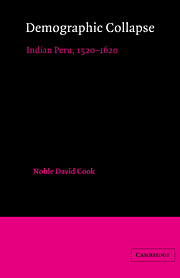Book contents
- Frontmatter
- Contents
- List of tables, figures, and maps
- Preface
- Introduction: The problem in perspective
- Part I Peru's preconquest population
- 1 The ecological approach
- 2 Population and archaeology
- 3 Depopulation ratios
- 4 Estimates from social organization
- 5 Disease mortality models
- 6 Census projections
- 7 Conclusion
- Part II Demographic collapse
- Abbreviations used in notes
- Notes
- Bibliography
- Index
- Titles in the series
2 - Population and archaeology
Published online by Cambridge University Press: 02 December 2009
- Frontmatter
- Contents
- List of tables, figures, and maps
- Preface
- Introduction: The problem in perspective
- Part I Peru's preconquest population
- 1 The ecological approach
- 2 Population and archaeology
- 3 Depopulation ratios
- 4 Estimates from social organization
- 5 Disease mortality models
- 6 Census projections
- 7 Conclusion
- Part II Demographic collapse
- Abbreviations used in notes
- Notes
- Bibliography
- Index
- Titles in the series
Summary
Archaeology is a fascinating exercise, but reason has to set bounds to extravagant flights of fancy when seeking to interpret the evidence of inert matter.
Nicolas Sanchez-Albornoz, Population of Latin America, p. xiiiIn 1965 I suggested that the pre-Spanish population of Peru could best be estimated by archaeologists after careful valley-by-valley investigation of sites and analysis of the productive capacity of ecological systems. As late as 1973 I continued to believe that archaeology held the key to an understanding of the native population. I overestimated, however, both the speed of archaeological fieldwork and the soundness of its methodology. Deriving population numbers from archaeological sources, whether skeletal remains, artifacts, remnants of foodstuffs, or mapping of settlement sites, is a very slow and painstaking process, fraught with major difficulties in the interpretation of the data. I have come to the conclusion that archaeological results covering large segments of the Andean region and providing noncontroversial population material will not be available in the immediate future. In this chapter we shall examine the general methods of paleodemographers and evaluate the potential of the information they can provide on prehistoric populations in the Americas as well as the limitations in their work. The chapter is organized thematically: We review the value of skeletal remains for population reconstruction, the relation of household dwelling area to the number of inhabitants, and human density and midden deposits; finally, we examine what monumental architecture and cities can tell us about population size. I shall attempt to limit the study chronologically to the two centuries preceding the arrival of Francisco Pizarro and his men on the South American west coast.
- Type
- Chapter
- Information
- Demographic CollapseIndian Peru, 1520–1620, pp. 30 - 40Publisher: Cambridge University PressPrint publication year: 1982



